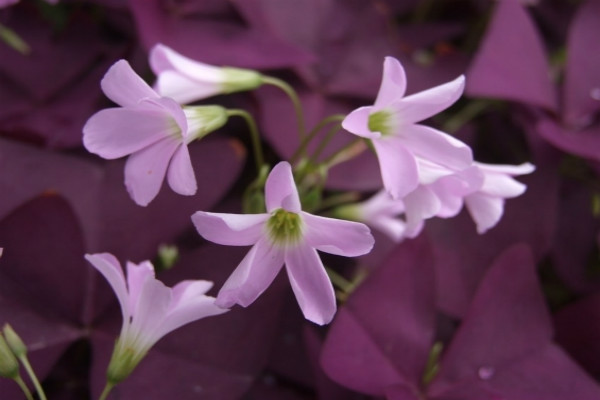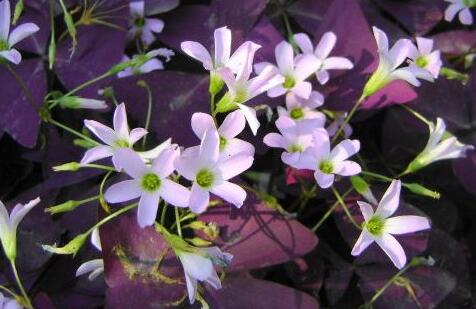Symptoms and Treatment of Myzus persicae Disease in Oxalis purpurea
1. Morphological characteristics
Peach aphids belong to Homoptera (Aphidoidea), also known as red aphids. Peach aphids are small, female aphids have black head and chest, 6 antennae, green, brown, yellow-green or reddish brown abdomen, and light black stripes on the back. The migration of male aphid is similar to that of female aphid in autumn, with larger black spots on the abdomen. The egg is long and oval, the first birth is yellowish green, and then it becomes black and shiny.
two。 Occurrence regularity
In the northern region, peach aphids can occur for more than 10 generations a year, and their life history is complex. Some of them are semi-periodic type (conservative type), and the other part of peach aphid is full-periodic type (migratory type). Semi-periodic peach aphids overwintering as egg or viviparous female aphids in vegetable cellars or greenhouses in the north. The full-cycle peach aphid overwinters in winter with eggs in branches, bud axils and cracks of Rosaceae fruit trees, and overwintering eggs hatch, feed and harm Oxalis in the middle and late April of the following year. The temperature is higher than 28 ℃ or less than 6 ℃, and the relative humidity is higher than 80% or less than 40%, which is disadvantageous to the development and reproduction of peach aphid. High temperature and torrential rain in summer had inhibitory effect on peach aphid. The winged peach aphid has a tendency to yellow, followed by green, and negative to silver gray.
3. Hazard characteristics
Peach aphids gather on the young leaves and buds of Oxalis purpurea, which in turn harms flowers and leaves as the buds open and young leaves unfold. Peach aphids pierce the plant tissue with piercing and sucking mouthparts to absorb juice, resulting in macular or black spots, wrinkled leaves, abnormal growth, flower bud atrophy and, in serious cases, plant death. Peach aphids can secrete honeydew, cause bacterial growth and induce other diseases. In addition, galls can be formed.
4. Prevention and cure measures
① agricultural prevention and control:
Combined with garden tending and maintenance management, clean protected areas, eradicate weeds, cut off residual flowers and leaves, pay special attention to cutting off insect leaves and seedlings, so as to prevent the spread and spread of insect pests.
Physical Prevention and Control of ②:
Yellow dishes or yellow thin plastic plates can be used to trap winged peach aphids, and aluminum foil or silver-gray plastic film can be set up in the border or greenhouse to avoid peach aphids.
Chemical control of ③:
In the initial stage of peach aphid damage, 40% dimethoate EC 50ml plus water 50kg and 50% malathion EC 50ml plus water 40kg spray can be selected. You can also choose 10% imidacloprid 50g plus 150g water spray, the control effect is remarkable.
④ biological control:
The natural enemies of peach aphids, such as Leis axyridis and Propylaea japonica, were protected and used for control.
Common insect pests of Oxalis purpurea and its control

Common insect pests of Oxalis purpurea
There are many common insect pests, such as cinnabar spider mite, sorrel rock mite, tobacco thrips, peach aphid and so on. Let's take a detailed look at the harm and control measures of these insect pests.
Pest control measures of Euphorbia purpurea L.
Cinnabar spider mites, also known as red spiders, usually occur frequently from mid-June to mid-August. In autumn they are often stored in groups in withered leaves, weeds, soil clods and bark crevices. The high temperature and dry season is the high incidence period of cinnabar spider mites, so preventive measures must be taken at this time. They will perch on the back of the leaves of Oxalis purpurea, causing the leaves to burn brown, causing the leaves to wither, and even cause the stagnation of plant growth and lead to the forehead death of spiders.
Prevention and control should be carried out in April. Triclofenac EC can be sprayed and must be sprayed when the scale is controllable. In ordinary times, it is necessary to often trim leaves and remove withered flowers and fallen leaves in time, which can also reduce the occurrence of insect pests.
Sorrel rock mite
The rock mite of sorrel grass is also called sorrel grass such as leaf mite. Go back to the plants for food in the autumn when the temperature is too low. The symptoms of damage are yellow-white or yellowish-green dots on the leaves, and in severe cases cause the leaves to wither. Dimethoate EC with 1500 times liquid should be used to control this kind of insect pests. Prevention and control of these pests in advance can reduce the damage to plants.
Tobacco thrips
Tobacco thrips, also known as onion thrips, often occur in March-April. This kind of insect pests are suitable to survive in a dry and rain-free environment. This kind of insect pests do great harm to Oxalis purpurea, which will lead to distorted and deformed leaves, brown markings on leaves, and in serious cases, stagnation of plant growth and death.
1000 times liquid fenitrothion can be selected, and omethoate can also be used, but not too much. Usually, it should be watered in time to remove weeds.
Peach aphid
This kind of insect pest usually does great harm to Oxalis purpurea in April. Peach aphids often appear on the young leaves and buds of Oxalis purpurea, which makes the leaves grow distorted, deformed and the buds atrophy.
We can choose imidacloprid and 150g water to make the spray, and the effect is remarkable. Similarly, in the usual breeding process, we should pay attention to clean up the withered leaves and flowers, and cut off the leaves with worms in time.
In the prevention and control of diseases and insect pests of sorrel, 5 major pest control skills / prevention is the key
Sorrel is a relatively easy plant to raise, but if it is often placed in a relatively extreme environment, or if the cultivation method of sorrel is not very scientific, it will lead to the emergence of sorrel mites, peach aphids and other pests on the plant, so when planting, flower friends should know some pest control methods of sorrel, so as to prevent sorrel from being disturbed by pests.
Control of diseases and insect pests of sorrel
1. Sorrel rock mite
In addition to harming sorrel, it may attack June snow, magnolia and other plants, mainly by piercing plant tissue to absorb juice, and then leave yellow and white dots on the surface of sorrel leaves, causing the leaves to turn yellow and wither.
Prevention and control methods: generally occur in early summer and mid-autumn, the control method is to spray drugs, such as 50% monocrotophos EC, 40% dimethoate EC 1500 times, etc., common acaricides are ineffective against this pest, and it is best to use a variety of agents to spray alternately.
2. Peach aphid
A pest belonging to the family aphidae, which not only does great harm but also has a large number of reproduction. It absorbs the juice from the leaves of Oxalis and secretes honeydew, so that Oxalis may be infected with coal fouling disease. It is very terrible in the pest control of Oxalis.
Prevention and control methods: when planting, pay attention to remove the weeds in the soil to avoid excessive air humidity. When there are pests, you need to spray drugs, generally use 1500 times 80% dichlorvos EC, or spray 1500 times 50% malathion EC, and so on.
3. Root rot
The root of sorrel is the main harm of root rot, it will lead to the lack of fertilizer and chlorosis of leaves, and the fibrous roots will be less, and the plants will wilt and lose energy when there is enough light during the day. in the end, it will cause sorrel to die due to lack of water.
Prevention and control methods: excessive fertilization and watering must be avoided, do not let the flowerpot stagnant water, and the concentration of fertilizer is not necessarily too high, disinfect the soil with fungicides before planting. 50% carbendazim can be sprayed 500 times after the onset of the disease.
4. Leaf spot
When the plant of sorrel is too dense and the light transmittance is relatively poor, it will easily cause leaf spot disease, which will not only make the leaves appear water-stained spots, but also produce a black powder-like mildew layer, which in serious cases will make the leaves dry and curl.
Prevention and treatment: if sorrel grows fast and many branches and leaves cross, you should pay attention to timely pruning, improve its light transmittance and keep the humidity not too high. At the same time, the plants were sprayed with drugs, such as 50% carbendazim 1000 times, 70% methyl topiramate, and so on.
5. Grey mold
It will not only harm the roots of sorrel, but may also harm its leaves. Brown patches appear on the leaves, and the roots rot, and the base fertilizer of the disease spots will produce a gray mildew layer, resulting in the death of the whole plant.
Prevention and control measures: reduce watering times and water quantity, usually avoid soil being too moist, increase the ventilation of the environment, reduce the humidity to less than 80%, and then carry out drug control to the diseased plants. 50% carbendazim 800 times solution and 50% carbendazim 500-800 times solution can be used for control.
- Prev

Symptoms and treatment of tobacco thrips disease in Oxalis purpurea
1. Thrips tabaci belongs to Thysanoptera family Thripidea. Thrips tabaci is small in size, 1.1-1.3mm in length; body color varies greatly, mainly black, brown or yellow; sucking mouthparts
- Next

Disease symptoms and treatment of mole cricket in North China of Oxalis purpurea
1. Morphological characteristics of mole cricket in North China belongs to Orthoptera (Gryllotalpidea), also known as Orthoptera. The adult is 36-55mm long and yellowish brown. The wing is short, the forefoot is flat and strong, and there is a thorn on the inner edge of the tibial segment of the hindfoot.
Related
- Fuxing push coffee new agricultural production and marketing class: lack of small-scale processing plants
- Jujube rice field leisure farm deep ploughing Yilan for five years to create a space for organic food and play
- Nongyu Farm-A trial of organic papaya for brave women with advanced technology
- Four points for attention in the prevention and control of diseases and insect pests of edible fungi
- How to add nutrient solution to Edible Fungi
- Is there any good way to control edible fungus mites?
- Open Inoculation Technology of Edible Fungi
- Is there any clever way to use fertilizer for edible fungus in winter?
- What agents are used to kill the pathogens of edible fungi in the mushroom shed?
- Rapid drying of Edible Fungi

